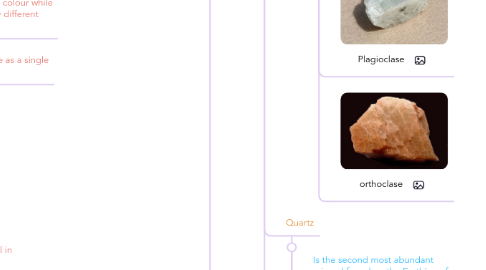
1. What is a rock?
1.1. Is a natural aggregatemade up of one or more types of minerals or mineral-like matter
1.2. magmatic rocks
1.2.1. plutonic rocks
1.2.1.1. Are formed by the sloow cooling down of magma under the Earth´s surface
1.2.1.2. This can take thousands even millions of years
1.2.1.3. Some ones are:
1.2.1.3.1. Granite
1.2.1.3.2. Syenite
1.2.2. Volcanic rocks
1.2.2.1. Are formed when magma reaches the Earth´s surface without cooling
1.2.2.2. Outside the magma cools and hardness rapidly
1.2.2.3. Examples:
1.2.2.3.1. Gabbro
1.2.2.3.2. Obsidian
1.2.2.3.3. Pumite
1.2.2.3.4. Basalt
1.3. Sedimentary rocks
1.3.1. Clastic rocks
1.3.1.1. Are formed from fragments of other rocks
1.3.2. Chemical rocks
1.3.2.1. Are formed by chemical processes
1.3.3. Biochemical rocks
1.3.3.1. Are form by the gradual accumulation of the remains of living things
1.3.3.2. Examples:
1.3.3.2.1. Shelly limestone
1.3.3.2.2. Coralline limestone
1.3.3.2.3. Coquina
1.3.3.2.4. Coal
1.3.3.2.5. Crude oil
1.4. Metamorphic rocks
1.4.1. Are produced from all types of pre-existing rocks
1.5. The rock cycle
1.5.1. Heat and preasure
1.5.1.1. Whit heat and preasure an igeneous rock or sedimentary rock is changed into a methamorphic rock
1.5.2. Weathering
1.5.2.1. The breaking down of rocks
1.5.3. Erosion
1.5.3.1. When wind, water, ice and gravity move pleces of rock and soil
1.5.4. Compacting
1.5.4.1. Squeezes layers of rock
1.5.5. Cementing
1.5.5.1. Glues sediments together
1.6. uhjug
2. What is a mineral? (part 1)
2.1. Is a natural solid and inorganic substance with a specific chemical composition and an ordened atomic arragement
2.2. Physical properties of a mineral
2.2.1. Shape of crystals
2.2.1.1. Mineral cristas occur in various shapes and sizes
2.2.1.2. The different shapes are determinated by the arragement of the elements that make the mineralsup and how they are joined together
2.2.2. Colour
2.2.2.1. Minerals have a distinctive colour while others can appear in many different colours
2.2.2.2. Colour alone is not reliable as a single identifying characteristics
2.2.3. Streak
2.2.3.1. Is the colour of the mineral in powdered form
2.2.3.2. While the colour of a mineral may vary from sample to sample, the streak usually dosen´t.
2.2.4. Lustre
2.2.4.1. Is the property that indicates how much the surface of a mineral reflects light
2.2.4.2. Lustre can be:
2.2.4.2.1. Metallic
2.2.4.2.2. Non-metallic
2.2.5. Cleavage
2.2.5.1. Is the tendency of a mineral to cleave, or break, along flat or even surfaces
2.2.6. Hardness
2.2.6.1. Is a measure of a mineral´s resistance to being scratched
2.2.6.2. Minerals are considered hard if they can scratch glass and soft if they can´t
2.2.6.3. It´s a relative scale of hardness (mosh scale) made up of ten reference minerals
2.2.6.3.1. 1- Talc
2.2.6.3.2. 2- Gypsum
2.2.6.3.3. 3- Calcite
2.2.6.3.4. 4- Fluorite
2.2.6.3.5. 5- Apatite
2.2.6.3.6. 6- Orthoclase
2.2.6.3.7. 7- Quartz
2.2.6.3.8. 8- Topaz
2.2.6.3.9. 9- Corundum
2.2.6.3.10. 10- Diamond
3. The use of minerals and rocks
3.1. Use of minerals
3.1.1. Are useful materials, are obtained from metallic minerals and rocks
3.1.2. Noble metals are used in jewellery like:
3.1.2.1. gold
3.1.2.2. silver
3.1.2.3. platinum
3.1.3. such as iron, copper, zinc, aluminium, lead, tin and mercury
3.1.3.1. iron
3.1.3.2. copper
3.1.3.3. zinc
3.1.3.4. aluminium
3.1.3.5. lead
3.1.3.6. tin
3.1.3.7. mercury
3.1.4. As precious stones or gemstones, such as:
3.1.4.1. diamond
3.1.4.2. sapphire
3.1.4.3. emerald
3.1.4.4. aquamarine
3.1.4.5. malachite
3.1.4.6. turquoise
3.1.4.7. amethist quartz
3.1.4.8. Ambar
3.1.4.9. Topaz
3.1.4.10. Peridot
3.1.4.11. Rodolite
3.1.4.12. Gamet
3.1.4.13. Ruby
3.1.4.14. Opal
3.1.4.15. Zircon
3.1.4.16. Alexandrite
3.1.4.17. Mint
3.1.4.18. Tangerine
3.1.4.19. Lavender
3.1.4.20. Citrine
3.1.4.21. Black zirconia
3.1.4.22. Tanzanite
3.1.4.23. Champagne
3.1.4.24. Carnelian
3.1.4.25. Apatite
3.1.4.26. And more...
3.1.5. Other uses of minerals:
3.1.5.1. Make pencils
3.1.5.1.1. Graphite
3.1.5.2. Human and animal food
3.1.5.2.1. Halite
3.1.5.3. manufacture sulphur
3.1.5.3.1. Pyrite
3.1.5.4. Make toothpaste
3.1.5.4.1. Fluorite
3.1.5.5. Make electrical componets
3.1.5.5.1. Quartz
3.1.5.6. Used in cosmetics
3.1.5.6.1. Talc
3.2. Use of rocks
3.2.1. The most common uses of rocks are as an energy source
3.2.1.1. Like:
3.2.1.1.1. Used as a fuel in power stations
3.2.2. Common uses for rocks are in construction, ornamentation and as industrial raw materias
3.2.2.1. Like:
3.2.2.1.1. Used in cement
3.2.2.1.2. Used to do clays
3.2.3. Other uses:
3.2.3.1. Like:
3.2.3.1.1. Used to make chalk
3.2.3.1.2. Used to make polishing materials
4. What is a mineral? (part 2)
4.1. Clasification of minerals
4.1.1. Silicates
4.1.1.1. Make up more than 90% of the Earth´s crust
4.1.1.2. There chemical composition always contains oxygen and silicon
4.1.1.3. Most common:
4.1.1.3.1. Feldspars
4.1.1.3.2. Quartz
4.1.1.3.3. Micas
4.1.2. Non-silicates
4.1.2.1. They don´t contain silicon
4.1.2.2. Most comon:
4.1.2.2.1. Carbonates
4.1.2.2.2. Halides
4.1.2.2.3. Sulfates
4.1.2.2.4. Sulfides
4.1.2.2.5. Oxides
4.1.2.2.6. Native elements
5. The internal structure of the Earth
5.1. The geosphere is the solid part of the Earth
5.2. There are two types of rocks
5.2.1. Heavy dense rocks
5.2.1.1. Are rich in iron and nickel,that start to sink to the center of the Earth
5.2.2. Lighter dense rocks
5.2.2.1. Are rich in silicates, that start to moved towards the Earth´s surface
5.3. These separation took millions of years and ended with the diferentiation of three major layers:
5.3.1. The crust
5.3.1.1. Is the outermost layer of the Earth.
5.3.1.2. It´s also the thinnest.
5.3.1.3. It´s from 6km to 70km
5.3.1.4. It´s made up of rocky materials in a solid state which form the continents and ocean bottoms.
5.3.1.5. Two tipes of crust:
5.3.1.5.1. Continental crust
5.3.1.5.2. Oceanic crust
5.3.2. The mantle
5.3.2.1. Is the second layer of the Earth under the crust
5.3.2.2. And extend to a depth of 2900km
5.3.2.3. It´s the thickest layer and contains both solid rocky materials
5.3.2.4. And fluid some viscous materials
5.3.2.5. It´s in the mantle where magma it´s found, is a mixture of minerals water vapour and other gases at high temperature
5.3.2.6. Two types of mantle:
5.3.2.6.1. Upper mantle
5.3.2.6.2. Lower mantle
5.3.3. The Core
5.3.3.1. Is the deepest layer
5.3.3.2. It´s from 2900km to 6371km
5.3.3.3. It´s composed primarily of a nickel-iron alloy
5.3.3.4. It´s made up of two layers:
5.3.3.4.1. Outer core
5.3.3.4.2. Inner core
